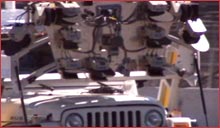|
|
|||||||||
|
|
|
|
|||||||
|
|
|||||||||
|
|
|
|
|||||||
|
|
|
|
|||||||
|
|
|
|
|||||||
|
|
Meet the Teams |
|
|||||||
|
|
|
|
|||||||
|
|
|
|
|||||||
|
|
|
|
|||||||
|
|
Affiliations: Entrepreneurs, Indiana University, Purdue University Hometown: Carmel, IN Leaders: Scott Jones and Doug Traster Team size: 35 Budget: $400,000 Key technologies: Stabilized sensor platform, including six lidar laser range finders, programmed to recognize different types of terrain and obstacles. Distributed processing system with 27 computers and visual-based road finding. Biggest challenge(s): Team project management with limited time and resources. Race results: Did not qualify due to severe sensor misalignment caused by a crash during a routine safety check. What they're up to now: Continuing to improve obstacle avoidance for IRV and other mobile robotic platforms. Where the vehicle is now: In Scott Jones's garage; sometimes taken out and run on the team's 40-acre obstacle course in a cornfield, which features mini-mountains, tunnels, ditches, moguls, etc. |
|
|||||||
|
|
|||||||||
|
|
|
|
